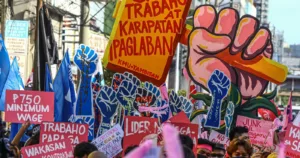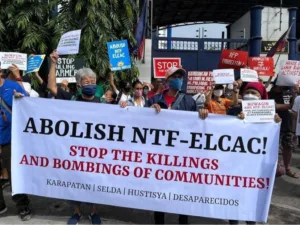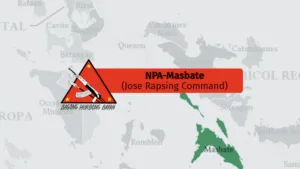Marco Valbuena | Chief Information Officer | Communist Party of the Philippines
1. Trump’s tariffs are the latest desperate measures to find a way out of the prolonged stagnation of the global capitalist system, and reverse the strategic economic decline of US imperialism. The declared objective of these tariffs is to protect the American economy, eliminate trade deficits, and help boost domestic manufacturing.
These protectionist measures are not new, and in fact, have been the underlying thrust of US economic policy over the past decade and a half. Since the financial crisis of 2008-2009, variants of these policies (“inshoring”, “Made in America”, “CHIPS Act”) have been implemented by the US government under the Obama, Trump (in his first term) and Biden regimes. The push towards protectionism is a shift from its previous lip-service to multilateralism (the so-called “rules-based international order”). The declared goal of past US governments has been to regain the industrial lead of the US.
Despite these measures, the US has struggled to regain its industrial dominance. Notably, the share of the US to global industrial output remains the lowest among G7 countries at 11% in the 2020s (down from 25% in the 1970s), while manufacturing’s share to GDP has fallen to 9.9%, from 28% during the 1950s, highlighting the long-running decline of the share of US industrial output.
All these tariffs and other protectionist measures of the US government have largely failed to counter the strategic decline of the US economy. Attempts of the US government to revive its industrial lead is weighed down by the capitalist crisis of overproduction.
Amid intense capitalist competition, attempts by the US to regain its manufacturing dominance and reverse its decline are being carried out with more than tariff measures, and involves the wage suppression and labor repression, substantial state subsidies and investments, and widespread destruction of productive forces. Furthermore, the US is seeking to radically redivide global markets and spheres of influence through saber-rattling and outright wars.
2. On April 2, Trump ordered an across-the-board 10% tariff on all US imports, effective on April 5, and higher “reciprocal” tariffs ranging from 11% to 50% on imports from 57 countries, that were supposed to take effect on April 9. This came one month after ordering a 25% tariff on all goods imported from Mexico and Canada (except oil and energy exports).
These announcements have resulted in great uncertainties for the American working class and the US economy. These tariffs are also expected to result in higher inflation and further push up cost of living. Estimates suggest that the annual average American household expenses will go up by at least $5,200.
There is widespread anticipation that slapping higher tariffs on all imported commodities will set off disruptions in supply chains and raise cost of production. The 25% tariff on vehicle parts are projected to cost US carmakers $108 billion and reduce production by 17.7 million vehicles. As a result of the tariffs, economists see an increased risk of a US recession within the next 12 months.
Almost immediately after the announcement, financial markets saw record losses and volatility. The US stock market suffered its worst two-day loss in history, which saw a $6.6 trillion drop in bond prices, followed by a three-day loss of around $10 trillion in global markets (equivalent to 10% of global GDP). The sharp decline in US stock market prices was accompanied by a fall and fluctuation in the yield of US Treasuries, indicating a loss of confidence on US bonds.
Amid the stock market chaos, Trump ordered a 90-day suspension of the “reciprocal” tariffs, which somewhat stabilized the financial markets. US stock prices rebounded but below levels prior to the tariff announcements.
Trump’s announcement of higher tariff measures, which triggered a stock market panic, followed by suspensions that led to rapid increases in stock prices, has also sparked speculations of potential corruption and insider trading, involving Trump officials, shell corporations, family members, cronies and Trump himself.
3. Trump’s tariffs directly undermine the multilateral system it has actively promoted along with its imperialist allies during the past decades of neoliberal globalization. These are bringing forth new aspects of inter-imperialist conflicts.
Trump has antagonized the traditional capitalist allies of the US. He has threatened to cut down by 25% Canadian steel and aluminum exports to the US. Exports to the US of various commodities from the European Union, including automobiles, chemicals, machinery, wine and luxury items, are also set to be reduced by 66%. In response to the “reciprocal” tariffs, the European Union and Canada declared they will implement retaliatory tariff measures. Earlier, Mexico responded with both tariff and non-tariff retaliatory measures to Trump’s high tariff measures.
The biggest target of Trump’s tariffs, however, is China. Along with the announcement of “reciprocal” tariffs, Trump raised tariffs on China to 104%. In its response, China announced it will raise tariffs on US commodities to 84%. Trump responded with an order to jack up tariffs on China to 145%, which elicited a Chinese counter-response of sharply raising tariffs to 125%. In addition, China has ordered export restrictions of seven types of rare earth minerals to the US. China is now actively courting countries severely affected by US tariffs and trade disruptions by promising them cooperation.
When Trump announced a 90-day suspension of reciprocal tariffs, he did not include those against Chinese goods. However, clearly bowing to the interests of billionaire tech oligarchs who import mostly their commodities from China, Trump exempted smartphones, computers and other electronic goods, which comprise close to 30% of US imports from China. Subsequently, US officials announced that the Trump government will issue another order in a month or two covering “semiconductor tariffs.”
The US tariff and trade war against China form part of the intensifying efforts of the US imperialists to contain the growth of its biggest imperialist rival. However, to the chagrin of US policy makers, leading US corporations in China plan to continue investing in the country to take advantage of the vast Chinese market, as well as in other countries, where the cost of labor is significantly lower than the US.
4. Trump’s tariffs clearly expose the neoliberal myth of “free trade.” The US imperialists have long peddled and forced the neoliberal policy regime to pry open the economies of its semicolonies and backward or weaker countries, in order to subject these to neocolonial plunder through liberalization of trade and investments policies, privatization and deregulation. Contrary to these “free trade” policies, Trump is now using tariffs as leverage to force countries to make deals that will serve the US economic and geopolitical interests.
It threatens to impose a 46% “reciprocal” tariff on Vietnam, whose exports to the US (mainly produced by Japanese, South Korean and American companies, are valued at 30% of its GDP). The US wants to force Vietnam to remove non-tariff barriers to allow the entry of more US goods. It also wants to stop the routing of Chinese goods for export to the US through Vietnam to evade US tariffs. Nike, for one, which produces half of its footwear in Vietnam, depends largely on supply chains from China. The US also wants Vietnam to allow the US to expand its military presence and increased sales and transfer of US military hardware, to draw it away from its historical security ties to China and Russia.
The US is also using high “reciprocal” tariffs on Malaysia (24%) and Indonesia (32%) to compel these countries to open their markets to more American commodities, and force a strategic economic realignment, away from China. The Trump government also seeks to deepen its military and security ties with these countries, as additional gain in its push its Indo-Pacific strategy to contain the growth of its imperialist rival China.
5. The US government plans to slap a 17% tariff on Philippines exports, as part of the “reciprocal” tariffs announced by Trump. These threaten as much as $12.14 billion of Philippine exports to the US, which is 16.6% of total Philippine exports (although close to half of these are electronic components of American subsidiaries that will be exempted under Trump’s subsequent orders).
Displaying gross subservience to the US and complete lack of national dignity, not a whimper of complaint or discontent was heard from Marcos nor his officials. On the contrary, they even expressed gratitude to the US for slapping the country with tariffs lower than Vietnam and other countries, and saw the disparity “as an opportunity to attract foreign investments.”
Unlike other self-respecting countries, officials of the US puppet Marcos government dismissed ideas of retaliating to the Trump tariffs. They expressed fears that such will raise the cost of local production, highlighting the country’s deep dependence on imports, particularly on some food commodities from the US.
Despite the US display of economic hostility towards the Philippines, Marcos and his officials, true to their fealty to their imperialist masters, are now desperately seeking to negotiate zero-to-zero tariffs with the US. Certainly, such a “free trade agreement” with the US will come at a high price on Philippine economic and political sovereignty. Pushing a “free trade” agreement between the US and the Philippines will only condemn the country further into economic subservience. It will only perpetuate the country’s dependence on imported materials, and the economy’s orientation towards export of assembly, semi-processing or raw materials.
By choosing a weak negotiating position, Marcos’ officials are giving the US more leverage to seek cheaper terms for Philippine minerals, and wider access to local market to dump American surplus commodities. It is like allowing the US to negotiate with itself.
In its desperation to seek US economic accommodations, the Marcos government is also providing the US imperialists with a wider berth to use the Philippines as a stronghold for its Indo-Pacific strategy, particularly after the US declared its “policy of deterrence,” using the Philippines as proxy, strengthening further its military presence in the Philippines and reinforcing its use of the country as its base for war exercises and provocations.
In the face of Trump’s tariffs, it is urgent for the Filipino people to carry forward the struggle for genuine national freedom, in order to carry out a program to attain economic sovereignty, with national industrialization and land reform as key components. Only by having economic sovereignty can the country be self-reliant, able to stand on its own feet, utilizing the country’s resources for the national good, and to ensure that the needs of the people are addressed.
6. The Trump government wields tariffs as a weapon of economic war, that form part of the US imperialist arsenal to upturn the multipolar world order and assert its status as the sole global superpower. It leverages its economic weight to contain the economic growth of China, force all other imperialist and capitalist powers to bow to its hegemony, and force the majority of weaker capitalist countries and semicolonies to open their resources to US imperialist control and plunder.
In asserting US global hegemony and pushing to redivide the world according to its interests, the Trump government is exposing and intensifying inter-imperialist contradictions and provoking conflicts around the world. Trump is proving himself not unlike the European fascist demagogues of the 1920s and 1930s who roused ultra-nationalism and autarky, as part of its preparations for war.
Along with the use of tariffs, the US continues to use its military dominance, directly or through proxy, across the world, with particular focus now on the so-called Indo-Pacific theater against China. The more the US asserts its dominance, the more conflicts it brings to the world.
The Filipino working class and people, along with other oppressed and exploited peoples of the world must continue to build an anti-imperialist united front to fight primarily US military and economic hegemonism, oppose war preparations and provocations. This united front must be ready to unite the broadest possible range of forces against US imperialism, take advantage of inter-imperialist contradictions, and help advance the struggle for national liberation in all parts of the world.
The post On Trump’s tariffs appeared first on PRWC | Philippine Revolution Web Central.











